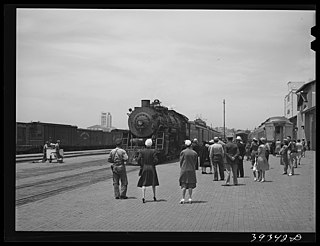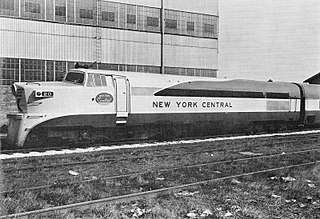Related Research Articles

Easley is a city in Pickens County in the State of South Carolina. Most of the city lies in Pickens County, with a small portion of the city in Anderson County.

The Baldwin Locomotive Works (BLW) was an American manufacturer of railroad locomotives from 1825 to 1951. Originally located in Philadelphia, it moved to nearby Eddystone, Pennsylvania, in the early 20th century. The company was for decades the world's largest producer of steam locomotives, but struggled to compete as demand switched to diesel locomotives. Baldwin produced the last of its 70,000-plus locomotives in 1951, before merging with the Lima-Hamilton Corporation on September 11, 1951, to form the Baldwin-Lima-Hamilton Corporation.

The Livonia, Avon and Lakeville Railroad is a short line railroad that operates in Livingston County and Monroe County in New York, United States. The railroad interchanges with CSX at Genesee Junction in Chili, New York, the Rochester and Southern Railroad (RSR) at Genesee Junction and the RSR's Brooks Avenue Yard in Gates, New York, and with the Rochester & Genesee Valley Railroad Museum at Industry, New York. Their primary freight consists of food products - grains and corn syrup. In 1997, the Livonia, Avon and Lakeville Railroad was selected as Short Line Railroad of the Year by industry trade journal Railway Age. The LAL is also the parent company for the Bath and Hammondsport Railroad, the Western New York and Pennsylvania Railroad and the Ontario Midland Railroad.
The East Tennessee & Western North Carolina Railroad, affectionately called the "Tweetsie" as a verbal acronym of its initials (ET&WNC) but also in reference to the sound of its steam whistles, was a primarily 3 ft narrow gauge railroad established in 1866 for the purpose of serving the mines at Cranberry, North Carolina.

The Black Hills Central Railroad is a heritage railroad that operates in Keystone, South Dakota, United States. The railroad was added to the National Register of Historic Places on February 5, 2003.

The Trona Railway is a 30.5 mi (49.1 km) short-line railroad owned by Searles Valley Minerals. The TRC interchanges with the Lone Pine Subdivision of the Union Pacific Railroad at Searles, California.
The Santa Maria Valley Railroad is a 14.8 miles (23.8 km) shortline railroad that interchanges with the Union Pacific Railroad's Coast Line at Guadalupe, California. As of 2006, the Railroad is owned by the Coast Belle Rail Corporation.
The Blue Ridge Railway was a 19th-century railroad in the U.S. state of South Carolina. It was originally chartered in 1852 as the Blue Ridge Railroad of South Carolina. Original plans were for a 195-mile line from Anderson, South Carolina, to Knoxville, Tennessee going through the mountains with as many as 13 tunnels including the incomplete Stumphouse Mountain Tunnel.

The Saluda River is a principal tributary of the Congaree River, about 200 mi (320 km) long, in northern and western South Carolina in the United States. Via the Congaree River, it is part of the watershed of the Santee River, which flows to the Atlantic Ocean.

The Valley Flyer was a short-lived named passenger train of the Atchison, Topeka and Santa Fe Railway.

The Indiana Transportation Museum is a railroad museum that was formerly located in the Forest Park neighborhood of Noblesville, Indiana, United States. It owns a variety of preserved railroad equipment, some of which still operate today. ITM is currently Located in Logansport, Indiana.
The Piedmont & Northern Railway was a heavy electric interurban company operating over two disconnected divisions in North and South Carolina. Tracks spanned 128 miles (206 km) total between the two segments, with the northern division running 24 miles (39 km) from Charlotte, to Gastonia, North Carolina, including a three-mile (5 km) spur to Belmont. The southern division main line ran 89 miles (143 km) from Greenwood to Spartanburg, South Carolina, with a 12 mi (19 km) spur to Anderson. Initially the railroad was electrified at 1500 volts DC, however, much of the electrification was abandoned when dieselisation was completed in 1954.
The Greenville and Western Railway is a Class III railroad that operates 12.74 miles (20.50 km) from a point south of Belton to Pelzer, South Carolina. Connections are made with Pickens Railway at Belton and CSX at Pelzer. The railroad is a subsidiary of Western Carolina Railway Service Corporation.
The Belton, Grandview and Kansas City Railroad (SHRX) is short line passenger railroad and museum located in Belton, Missouri. It operates as a heritage railroad, on what was once the St. Louis and San Francisco Railway (Frisco), on the Kansas City to Springfield branch. With the merger of the Frisco with the Burlington Northern, the line was partially sold to the Kansas City Southern Railway north of 155th Street. The north of the line is used once a year when tree trimming/weed spraying takes place, and the tracks are bad though can still can be used. The bridge is still there past Markey Road but with missing ties, while the southernmost portion from Peculiar, MO. to Clinton, MO. has been scrapped and abandoned. This left the remaining trackage of a few miles connecting Grandview and Belton, Missouri. The railroad currently operates a 1952 GM GP 9 locomotive, which is used to pull an excursion train. Also included in the railroad's collection are various locomotives, cars and equipment.

The RP-210 was a streamlined 1,000 hp (750 kW) locomotive built in 1956 by Baldwin-Lima-Hamilton, specifically to operate with the experimental, all-aluminum Train-X coaches that the Pullman-Standard Car Manufacturing Company built. The model represented Baldwin's attempted entry into the lightweight passenger locomotive market, but only three of the low-slung diesel-hydraulic units were produced. The first was built for the New York Central Railroad to power their Ohio Xplorer train between Cleveland, Columbus, and Cincinnati, and a pair was purchased by the New York, New Haven and Hartford Railroad to double-end their Dan'l Webster, running between New York City and Boston.
The Three Rivers Rambler is an Excursion train in Knoxville, Tennessee along the Tennessee River. The train is operated by the Knoxville and Holston River Railroad, a subsidiary of Gulf and Ohio Railways.

The Stone Mountain Scenic Railroad (SMRR) is a standard gauge railroad that circles the perimeter of Stone Mountain Park in a loop, and provides views of the mountain en route.
The Pickens Railroad is a shortline railroad that operates in the South Carolina Upstate region for more than a century, beginning in the 1890s.
The Thermal Belt Railway is a Class III shortline railroad that operates for freight service on an irregular schedule on a former CSX line from Bostic to Forest City and on a former Norfolk Southern line from Forest City to Alexander Mills, North Carolina. Total mileage is 8.5 miles (13.7 km). Connections are made with CSX at Bostic. Rail is 85 pounds.
References
- 1 2 "Pickens Railroad Started 1898". The Pickens Sentinel. September 30, 1968. p. 2.
- ↑ The Baldwin Diesel Zone - RP-210
- ↑ Ardinger, Ken (September–October 1996). "Locomotive Notes II". Diesel Era. Montoursville, Pennsylvania. 7 (5): 61.